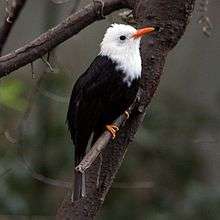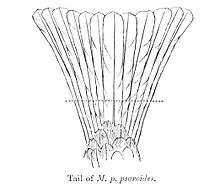Black bulbul
| Black bulbul | |
|---|---|
 | |
| Scientific classification | |
| Kingdom: | Animalia |
| Phylum: | Chordata |
| Class: | Aves |
| Order: | Passeriformes |
| Family: | Pycnonotidae |
| Genus: | Hypsipetes |
| Species: | H. leucocephalus |
| Binomial name | |
| Hypsipetes leucocephalus Gmelin, 1789 | |
 | |
| Rough distribution of South Asian species within the complex | |
The black bulbul (Hypsipetes leucocephalus), also known as the Himalayan black bulbul or Asian black bulbul, is a member of the bulbul family of passerine birds. It is found in southern Asia from India east to southern China. It is the type species of the genus Hypsipetes, established by Nicholas Aylward Vigors in the early 1830s.[2] There are a number of subspecies across Asia, mostly varying in the shade of the body plumage (ranging from grey to black), and some also occur in white-headed morphs (as also suggested by its specific epithet leucocephalus, literally "white head"). The legs and bill are always rich orange-red. The related form from the Western Ghats and Sri Lanka is often treated as a separated species, the square-tailed bulbul (Hypsipetes ganeesa).
Description

The black bulbul is 24–25 cm in length, with a long tail. The body plumage ranges from slate grey to shimmering black, depending on the race. The beak, legs, and feet are all orange and the head has a black fluffy crest. Sexes are similar in plumage, but young birds lack the crest, have whitish underparts with a grey breast band, and have a brown tint to the upperparts. They have a black streak behind the eye and on the ear coverts.[3][4][5]
Taxonomy and systematics

The taxonomy is complex with this and several other currently recognized species earlier treated as subspecies of Hypsipetes madagascariensis.[6] Within Asia, ganeesa has often been considered as a subspecies of H. leucocephalus, but is here treated as a separate species restricted to the Western Ghats (south of somewhere near Bombay[7] ) and Sri Lanka, the square-tailed black bulbul. The subspecies from Sri Lanka humii is then placed under this species.[8]
The nominate race leucocephalus (J. F. Gmelin, 1789) is found north and east of the Himalayas in south eastern China, Myanmar and Indochina. The race psaroides Vigors, 1831 is found along the Himalayas from Afghanistan (Kunar Valley), through, Pakistan and India (Arunachal Pradesh) into northwestern Myanmar. Race sinensis (La Touche, 1922) is found in China, Thailand, Laos and Vietnam. Race nigrescens Stuart Baker, 1917 is described from Assam, Manipur, Myanmar (Chin Hills). Several other subspecies have been proposed including stresemanni, ambiens, concolor (may include impar), leucothorax, nigerrimus and perniger. Of all the races of this bulbul, stresemanni, leucothorax and leucocephalus have white heads, while all the others are black-headed. One of the white-headed races of this bulbul has been reported from Namdapha National Park in Arunachal Pradesh in Northeast India in 2009.[9] The reproductive isolation mechanisms such as vocalization and geographic distributions of these populations still remain to be studied.[10]
Behaviour and ecology


This bulbul is found in broad-leaved forests, cultivation and gardens mainly in hilly areas, but Himalayan populations are known to sometimes descend into the adjoining plains in winter.[8][11][12]
Black bulbuls feed mainly on seeds and insects, and they are often seen in small groups, either roosting or flying about in search of food. They are particularly fond of berries. They are known to feed on a wide range of berries including Celtis, Rosa, Melia and Ehretia in the Himalayas.[13] They feed on the nectar of Salmalia, Erythrina, Rhododendron and other species. They make aerial sallies for insects.[8] They can be quite noisy, making various loud cheeping, mewing and grating calls.[3] The Himalayan form has been reported to make a call resembling a goat kid, throwing back its neck when calling.[14]
It builds its nest in a tree or bush; the nest is a cup placed in a fork and made from grasses, dry leaves, mosses, lichens and cobwebs. The lining is made up of ferns, rootlets and other soft material.[15] Both sexes participate in nest construction. Two or three eggs form the usual clutch.
References
- ↑ BirdLife International (2012). "Hypsipetes leucocephalus". IUCN Red List of Threatened Species. Version 2013.2. International Union for Conservation of Nature. Retrieved 26 November 2013.
- ↑ Gregory, Steven M. (2000). "Nomenclature of the Hypsipetes Bulbuls (Pycnonotidae)" (PDF). Forktail. 16: 164–166.
- 1 2 Ali, S & S D Ripley (1996). Handbook of the birds of India and Pakistan. 6 (2nd ed.). Oxford University Press. pp. 109–113.
- ↑ Blanford WT (1889). The Fauna of British India, Including Ceylon and Burma. Birds. Volume 1. Taylor and Francis, London. pp. 259–263.
- ↑ Baker, ECS (1924). The Fauna of British India, Including Ceylon and Burma. Birds. 1 (2nd ed.). Taylor and Francis, London. pp. 368–373.
- ↑ Warren BH, Bermingham E, RP Prys-Jones & C Thebaud (2005) Tracking island colonization history and phenotypic shifts in Indian Ocean bulbuls (Hypsipetes: Pycnonotidae). Biological Journal of the Linnean Society 85:271–287 PDF
- ↑ Khacher, Lavkumar J (1979). "Northward extension of the range of the South Indian Black Bulbul Hypsipetes madagascariensis Sykes". J. Bombay Nat. Hist. Soc. 76 (2): 364–365.
- 1 2 3 Rasmussen PC & JC Anderton (2005). Birds of South Asia. The Ripley Guide. Volume 2. Smithsonian Institution & Lynx Edicions. pp. 342–344.
- ↑ Srinivasan, U.; Dalvi, S.; Yobin, K. (2009). "First records of 'white-headed' Black Bulbul Hypsipetes leucocephalus from India". Indian Birds. 5 (1): 28–30.
- ↑ Dickinson, E.C.; R.W.R.J. Dekker; S. Eck; S. Somadikarta (2002). "Systematic notes on Asian birds. 26. Types of the Pycnonotidae" (PDF). Zool. Verh. Leiden. 340: 115–160. Archived from the original (PDF) on 2007-10-25.
- ↑ Raza, RH (1993). "Sighting of Black Bulbul Hypsipetes madagascariensis (P.L.S. Muller) in Gaya, Bihar". J. Bombay Nat. Hist. Soc. 90 (2): 291.
- ↑ Gaston,AJ (1972). "Black Bulbuls Hypsipetes madagascariensis (P.L.S. Muller) in Delhi". J. Bombay Nat. Hist. Soc. 69 (3): 651–652.
- ↑ Narang,ML; Rana,RS (1999). "Black Bulbuls association with Melia azedarach". Newsletter for Birdwatchers. 38 (6): 104.
- ↑ Page, WT (1903). "The Himalayan Black Bulbul. Hypsipetes psaroides". Avicultural Magazine. 1 (6): 209–211.
- ↑ Hume, AO (1889). The nests and eggs of Indian birds. 1 (2nd ed.). R H Porter, London. pp. 164–168.
